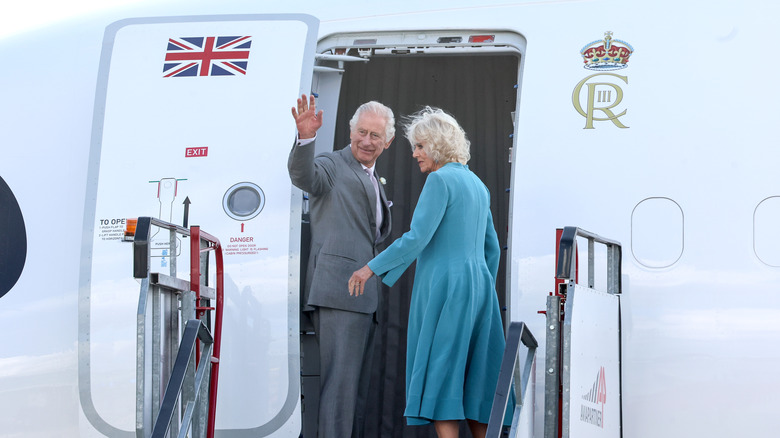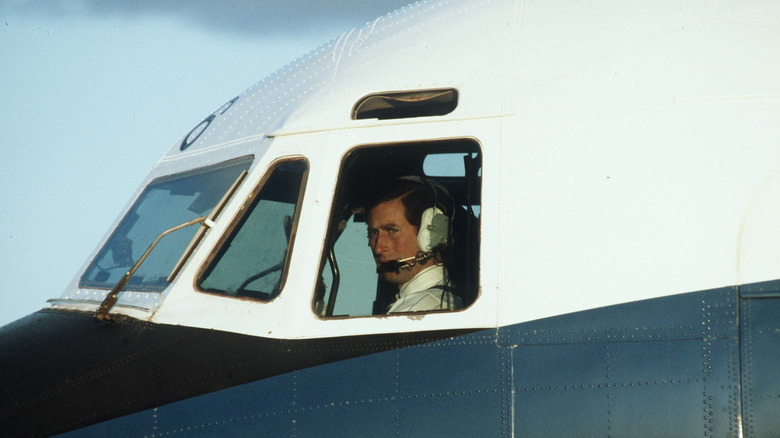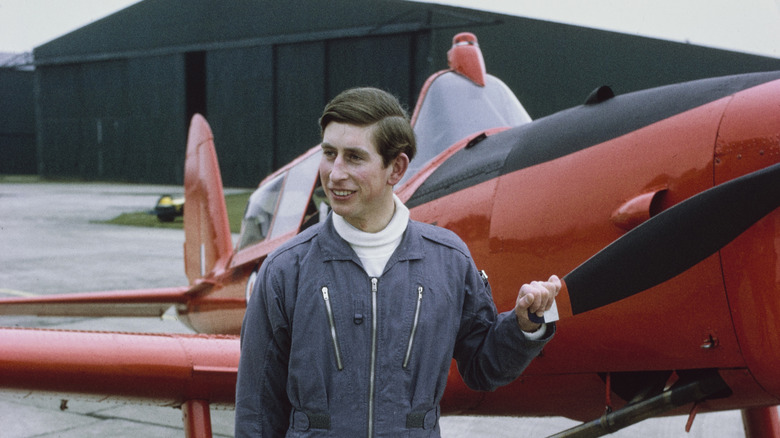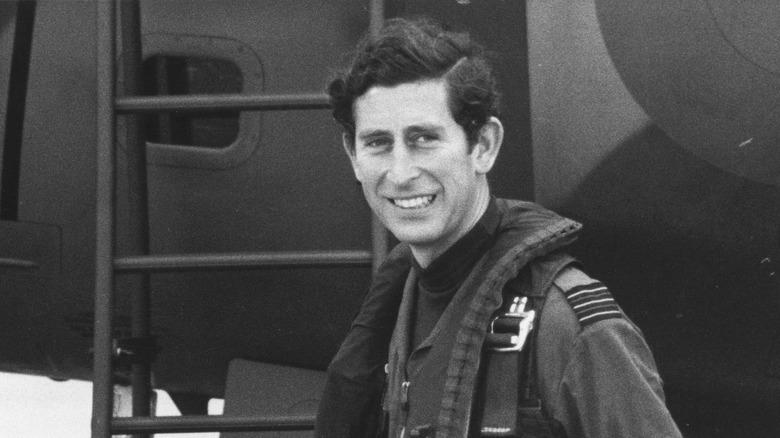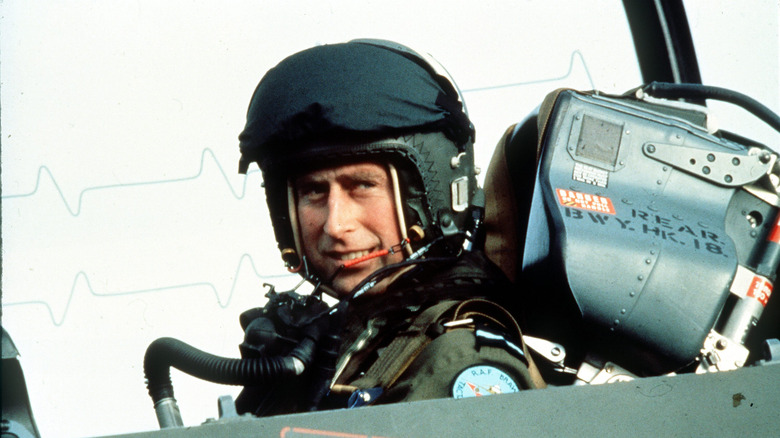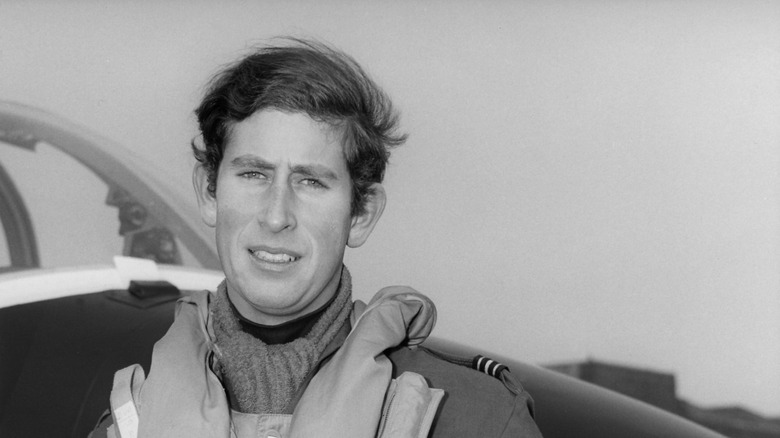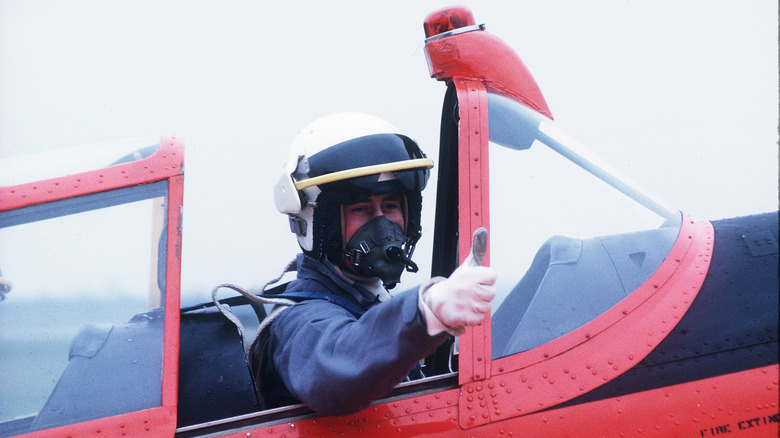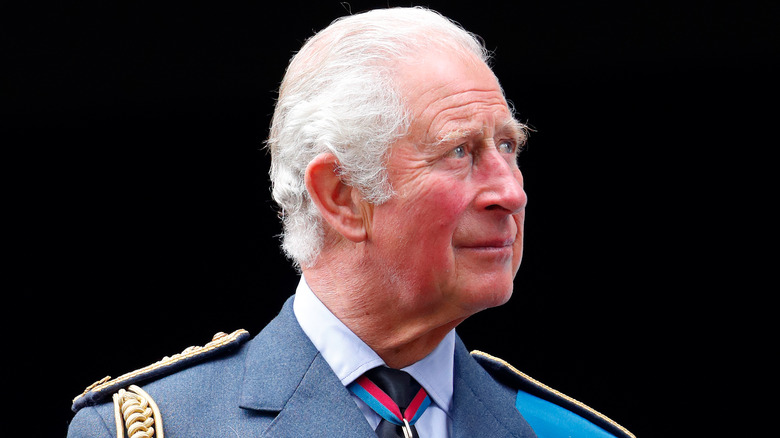King Charles' History Of Flying Planes And Why He Stopped
When it comes to aviation and the British royal family, it seems like the two go hand-in-hand. According to the Royal Air Force Museum, these connections all started in 1909 when King Edward VII, who was Queen Elizabeth II's great-grandfather, met the Wright brothers and became interested in their aircraft. Within a decade, members of the British royal family started riding on aircraft, with some even learning how to pilot themselves!
This passion for flying eventually passed on to King Charles III, who was known for not only having an affinity for air travel, but who was also an avid pilot himself. He put his skills to work with the British military in several different capacities, and he even managed to fly himself to various personal events. Yet, while Charles' personal piloting days suddenly stopped in the mid-1990s, his love for aviation seemingly never ceased. Since ascending to the throne after his mother's death, King Charles has understandably been busy taking on new roles, but his piloting days stopped long before Queen Elizabeth II died in 2022.
Historians speculate that King Charles liked flying for the thrills
King Charles III is known for his personal passion for air travel, but he's not the only British royal who loved aviation. In fact, his maternal grandfather, King George VI, was among the first British royal family members who flew after he started taking lessons with the Royal Air Force in 1919, when he was still known as Prince Albert.
Not only did the men seem to love piloting on his mother's side of the family, but Charles' father, Prince Philip, also had a passion for flying, too, having learned how to pilot in the 1950s. "Part of the attraction of air travel must be the risks," royal historian David McClure told People. "It's a sense of adventure. I suspect they quite like the thrill of putting their life on the line." Whatever the exact reason, the British royals obviously love flying. King Charles seemed to also pass on this passion to his sons, Prince William and Prince Harry, who went on to serve in the British military as pilots. The love of flying also didn't come without risks, as Queen Elizabeth II's older brother, William, died in a piloting competition in 1972.
King Charles made his first solo flight in 1969
While it's not clear exactly when King Charles III first became interested in flying, we do know that he took concrete steps towards his future as a pilot while he was a young student. According to the Daily Mail, King Charles received training while he was enrolled at Cambridge University and made his first flight in January 1969 in an aircraft called the Royal de Havilland Chipmunk WP903 (nicknamed the "Red Dragon"). The tandem aircraft was primarily used as a trainer craft for new pilots. As the Daily Mail reported, Charles made 101 flights in the aircraft while under the supervision of flight instructor and Squadron Leader, Philip Pinney.
Charles, then the Prince of Wales, was only in his early 20s at the time of his pilot training and first solo flight. Just two months later, Charles obtained his own license to fly private planes in March 1969. According to the Royal Chipmunk official website, Charles later obtained a preliminary flying badge for the Royal Air Force in August 1969. It's evident that Charles had a knack for flying, and was pursuing his interest in it rather quickly!
King Charles joined the Royal Air Force and the Royal Navy
Soon after getting his pilot's license and finishing a major in archaeology and history at Cambridge University in 1970, King Charles III went on to join the Royal Air Force in 1971. In fact, according to his official website, Charles literally flew himself to the training facility in Cranwell, Lincolnshire. After earning his coveted Royal Air Force "pilot's wings," Charles went on to attend the Royal Naval College. He went on to train as a helicopter pilot and joined a Royal Naval Air Squadron. The royal's official naval military service ended in 1976.
Today, the Royal Air Force museum features some of the aircraft flown by King Charles III. In addition to his impressive piloting skills, Charles was also trained in parachuting for the Army, and he even became the Colonel in Chief for the Parachute Regiment in 1977. While taking the parachuting course wasn't a requirement for his title, Charles said, as reported by MOD Crown, "I felt I should lead from the front, or at least be able to do some of the things that one expects others to do for the country."
King Charles often flew himself to various royal engagements
While King Charles III served in both the Royal Air Force and Royal Navy, he still had outside engagements he had to keep up with as a British royal. Interestingly, then-Prince Charles often flew himself to such events. Most of his personal piloting took place on the No. 32 Royal Squadron, which was an aircraft belonging to a unit dubbed "the Queen's Flight," according to Vintage Aviation News. He regularly flew planes as part of the Royal flight up through the mid-1990s.
As Prince of Wales at the time, Charles' duties included representing Queen Elizabeth II at various royal engagements around the world and welcoming world leaders to England. After receiving his pilot's license, some of these events Prince Charles attended included Germany and the Caribbean in 1973, Australia and New Zealand in 1974, and Nepal and India in 1975. While the transportation details of these trips aren't clear, it's likely that Charles flew himself and other members of the royal family whenever he had a chance!
King Charles experienced a bad landing in 1994
By 1994, King Charles III had piloted planes for more than two decades. Yet this was also the same year that he experienced his first major accident. In the June 1994 incident, Charles took over piloting duties from Squadron Leader Graham Laurie during a flight around Islay, Scotland. When attempting to land the British Aerospace 146 plane of the Queen's flight, the craft landed in a ditch. According to the Daily Mail, none of the 11 people on board were hurt, but the plane itself suffered significant damage, including its landing gear and nose cone. It was also estimated that Charles may have been piloting at too high of a speed when landing.
"It was not quite a crash," The Herald Scotland quoted Charles as saying after the accident. "We went off the end of the runway. It's not something I recommend happening all the time, but unfortunately it did." Yet experts still considered the landing to technically be classified as a crash, and the aircraft also sustained over $1 million worth of damage. "With hindsight, which is a wonderful thing, I should have got him to overshoot and try a different approach, but I told him to land, so he did exactly what he was told to do," Laurie said, as reported by People.
The incident made King Charles give up his pilot's license
The Royal Air Force conducted a full investigation into the 1994 plane crash in Scotland. In the end, they concluded about a year later that the aircraft's official pilot, Graham Laurie, was "negligent in the final stages of the flight" when he gave then-Prince Charles control of the plane, as reported in July 1995 by the Independent. While Laurie was still allowed to fly after this time, he was abolished from instructor and supervisor roles as punishment for the accident.
In all, Charles was not found at fault for the 1994 accident. Yet despite this, he gave up his pilot's license after the Royal Air Force investigation. "I was keen to stop the aircraft to put it mildly and tried to turn it off," Laurie recalled in an interview published in Hello magazine. "But we were going, we went off the runway probably doing only about ten miles an hour or something like that. It wasn't careering off the runway. It was one of those things, not my proudest moment. I was very sorry it happened. And it certainly wasn't his fault." Charles has never spoken publicly about whether he felt he held any responsibility, but it seems that the accident was too close of a call for him to re-live.
King Charles still honors his piloting days in the Royal Air Force
While King Charles III gave up his personal flying license nearly two decades ago, the British royal still honors his piloting days. One example was the 2023 Sovereign's Parade, an annual event that was the first one he attended as King. Here, in April 2023, King Charles congratulated and addressed recent graduates of the Royal Military Academy Sandhurst. There were 171 cadets at this year's Sovereign's Parade, and it was also the 200th event of its kind. "Having attended — and survived — two of the other military academies 50 years ago, I think I have some idea of the challenges which are inherent in military training," Charles said in a speech, as quoted by Vanity Fair. "I have experienced the nerves, the exhaustion — even the self-doubt — but, despite such recollections, it is the lifelong friendships which are forged through shared hardship, and the humor that you find in the darkest hours of the coldest, wettest nights, which remain with you."
What was also notable was King Charles' attire, as he chose to wear his full military uniform to the event. Interestingly, while both his sons, Prince William and Prince Harry, previously finished their own training at Royal Military Academy Sandhurst, King Charles trained elsewhere. Nevertheless, his pride in having served in the capacity of aviation for the Royal Military was evident at this event. Even if King Charles is no longer flying himself, his passion for flying likely remains, and he has numerous memories to look back on.
